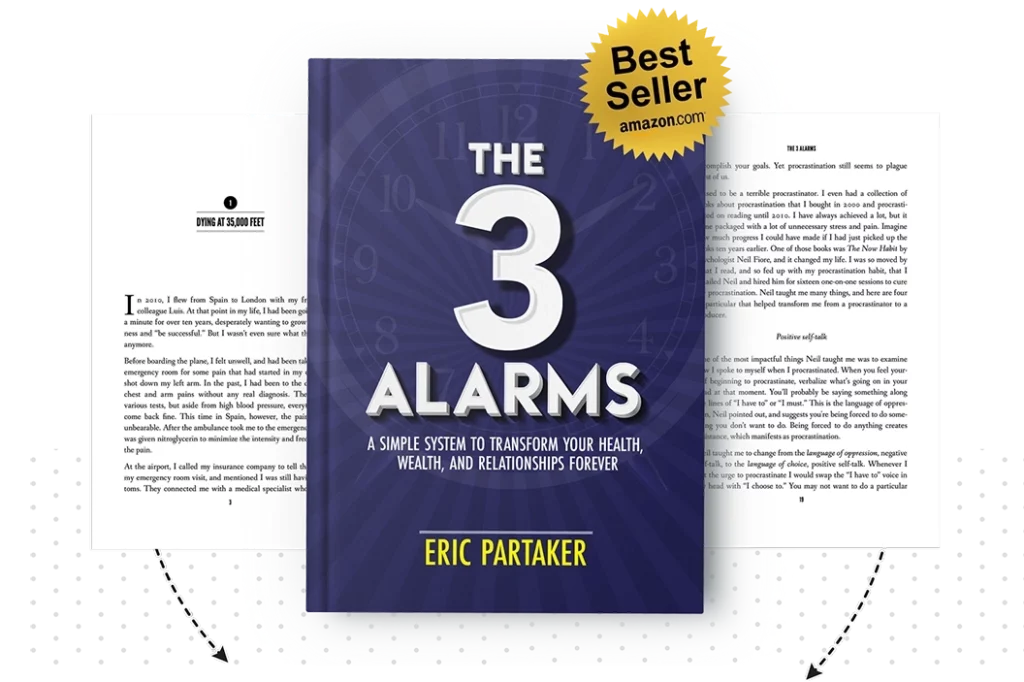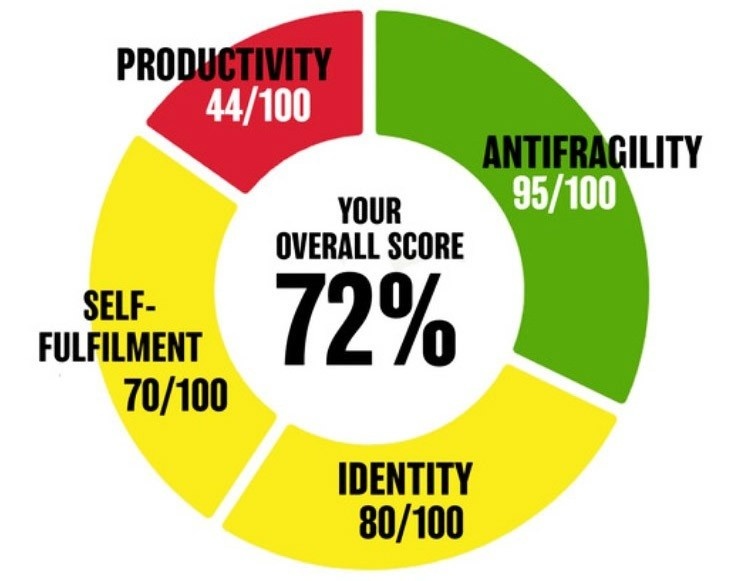SUMMARY
- Imagine three groups of people. The first group experiences virtually no stress, the second group experiences stress, but views it positively, and the third group experiences stress, but views it negatively. Which group do you think lives the longest? It’s the second group, the one that views stress positively.
- Contrary to popular belief, stress actually makes us stronger, provided that we look at it in the right way. You need to reframe stress to see every moment of adversity and every challenge as an opportunity to grow and complete a repetition in the gym of life.
- Every single thing that doesn’t go our way is a chance for us to respond more optimally. By doing that continually and reframing how we approach things, we can get better and better at responding to the very things that cause us stress
- Create space between stimulus and response so that you can choose the optimal response. Think about the things that trigger you and how you would respond. Now, think about how the best version of yourself would respond. Pause and create space between whatever that stimulus is and your response to choose the best action.
- Handle stress better by hiring a coach – by having someone to both support you and challenge you, you’re more likely to create better processes and handle those stressful events when they occur in the future.
TRANSCRIPT
Imagine three groups of people. The first group experiences virtually no stress – a stress free life. The second group experiences stress, but views it positively, and the third group experiences stress, but views it negatively. Which group do you think lives the longest?
It’s the second group, the group experiencing stress, but viewing it positively actually outlives the group that experiences virtually no stress or pretty much lives a stress-free life. Now you may have thought up to this point that stress is something that you should be avoiding, but it’s actually not stress, it’s you. It’s your view of stress that is potentially making life a lot harder for you and could potentially kill you. So actually what we need to be doing is thinking differently about how we handle stress and how we process it. That’s what I want to talk to you about today.
My name is Eric Partaker. Today I want to tell you a bit about my struggle with stress, my journey through it all, and some tips and tricks that you can use to better handle stress in your life, benefit from it and actually become stronger as a result of it.
For me personally, stress was absolutely something that I was constantly seeking to avoid. How do I meditate my way out of experiencing any stress whatsoever? How do I avoid stressful situations? How do I have less stress in my life? I was actually starting to stress myself out by trying to pursue this stress-free life, when suddenly I discovered that there’s a whole other approach out there, there’s a whole other way of dealing with stress. There’s a lot of evidence and research showing that, as I said to start off this video, that it’s actually our view on stress, which is the key thing.
That stress is actually something that makes us stronger. Now you might be thinking that stress doesn’t really make us stronger, but you’d be wrong there because there are lots of areas, for example, within our body where stress actually improves us. UV radiation in small doses actually repairs tissues in our body, exposure to germs and bacteria builds our immune system, and when we stress a muscle, it causes it to grow.
So in actuality, our response to stress which is naturally happening within our body, this positive view on stress, we just need to get it up here in our heads.
The first way we do that is by reframing stress. Think about every moment of adversity, every challenge, every thing that doesn’t go your way. Rather than these being things that upset you, we can start to view these things as repetitions in the gym of life. Each and every one of these things represents a chance for ourselves to complete that repetition, complete that challenge, so that we can turn challenge into growth and become stronger as a result.
In a way, we can turn life into one big mental gym. It becomes our training camp. Whereas we go to the gym physically, let’s say we go to the gym to work out for 30 minutes or an hour a day. The entire day can be our training camp, the entire day can be our gym. Every single thing that doesn’t go our way is a chance for us to respond in a more optimal and a better way to whatever that was. By doing that continually, by first reframing how we approach things, we can get better and better at responding to the very things that trigger us or that cause stress in our life. So the first thing, just to recap, is reframe stress. Stress is not something bad for you. Stress is actually something, that if you view it positively, can strengthen you. Your body already naturally does this, so it’s about just getting it up here in your head.
Now here’s a simple tool that will help you once you’re at that stage of, “I’m ready to reframe stress. How do I actually do that?” This tool is all about creating space. Creating space between stimulus and response so that you can choose the optimal response. How do we go about doing this? Well, first I’d like you to think about the things that trigger you. What are the things that really get you upset and drive you up the wall? It could be a pet peeve behavior in a friend, or a family member, or a colleague. It could be when somebody cuts you off in traffic. It could be when you don’t hit your goals. Maybe your company or your team isn’t performing as much as you would like and that’s stressing you out.
Think about the things that trigger you and write that list down. Visualize when those triggers happen, picture it like a film in your head. How do you typically respond? How do you respond to each and every one of those moments? What you’ll probably notice is that that response, whatever it may be, is typically a suboptimal response. What I mean is that it’s not the same response to the very best version of you would give, or like the 95 year old wisest version of you. It’s something less than that. Very often that response is an emotional response as well. Emotional responses come from the more ancient part of our brain. So what we want to get really good at is creating space between stimulus – whatever that thing is that’s triggering you and causing you stress – and how we respond.
We can respond in a stressed out way, or we can respond with a bit more control, a bit more strength, a bit more resilience. Wouldn’t you like to be responding to things in life, things that are stressing you out in a more calm, focused and resilient way? Wouldn’t you want the strength to do that? This technique here is a way to practice that and strengthen that muscle. We create space by simply pausing. So whatever’s triggering us, don’t respond right away. Pause. A pause could be a deep breath, it could be walking out of the room, it could be going for a walk. Create space, a tiny moment of awareness between whatever that stimulus is and your response, so that you can choose an optimal response. Remember, I was saying how the typical response pattern is an emotional response coming from the more ancient part of your brain.
When you pause and create space, you give yourself an opportunity to turn on this part of your brain – the prefrontal cortex – so that you can literally choose how you should respond. You can choose the response that you think would be most consistent with the best version of you. How would the best version of you respond in that situation? The most courageous version of you? How would that 95 year-old version of you respond? That same visualization exercise that I was saying where you picture the things that trigger you and you picture the way that you typically respond. Once you summon that best version of you, you can also visualize, “Well, how would that best version of me respond to each of those situations?” If all you do when those situations in the future pop up is just focus on creating space, a pause between the stimulus and response, you’re more likely to call up that best version of you, response to whatever that stressful trigger is in your life.
So, we have reframing stress as our first thing. We have creating some space between stimulus and response so that we can get better at choosing an optimal response as the second thing.
The third and final thing that you can be doing to better handle stress is hire a coach. Now, coaching is something that has been used in sports and in the upper realms of business for years. We see coaches in music and entertainment, and in the military. There’s always going to be things that you don’t see. There’s always going to be things that when they hit you, will stress you out and you’ll feel completely unprepared for them, no matter how much you might try to prepare in advance.
By having that coach there, by having someone to both support you and challenge you, you’re more likely to prompt better process and handle those stressful events when they occur in the future.
Great tips for choosing a coach are to choose somebody that you like, choose somebody that has been perhaps in the trenches themselves doing the types of things that you’re doing, and choose someone that you think you can have a great relationship with. One of the simpler ways to establish that is by just trying some different coaches out and finding the one that fits for you. Having that support in the form of a coach will also help you better process and handle stress.
So we’re reframing stress, we’re creating space when the things that stress us out happen so that we can choose the optimal response, and we’re thinking about how we can bring a coach into the fold to help us better handle the unexpected.
Now, I just want to leave you with a quick story. We’ll call this person Tony. He’s one of my coaching clients, CEO of several different companies. Everything was great in Tony’s life, except the relationship with his youngest son. I asked him to go into detail on that and describe what’s going wrong in the relationship. Tony proceeded to tell me that there were certain things that his son did that just drove him up the wall, and it always brought out the worst in him. They were things like, just not listening to what he asks him to do, having difficulty getting him to settle down at night for bed, or having difficulty getting him to sit down and do his reading. I asked Tony to, in those moments, picture each of them happening. Picture now, how you currently respond.
Now I want you to picture, how would the best version of you respond? The wisest, strongest version of you? Of course, those response patterns were different from how he typically responded. Then I focused Tony on just creating space. I said, “When those trigger events happen in the future, just create space, a tiny bit of awareness between the stimulus and the response so that you can choose your optimal response.” Over time, Tony started to respond to his son in the way that he had envisioned the best version of him would respond. But just by focusing on creating space, after the things that were triggering him. Over time, Tony said his relationship with his son dramatically improved and is now one of the strongest relationships that he has in his life today.
So, I hope you get a lot better at processing stress by realizing that it’s not stress, it’s your approach to it. We can reframe it, we can create space, and we can also bring in other people to help us in the form of a coach or a mentor.




